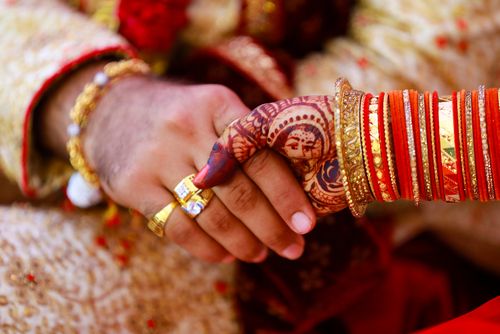 The Hindu wedding ceremony comprises many smaller rituals that occur over the course of several days. Each ritual has a special meaning for the couple. Many involve blessings by the family. Here are a few of the many rituals that take place during a Hindu wedding.
The Hindu wedding ceremony comprises many smaller rituals that occur over the course of several days. Each ritual has a special meaning for the couple. Many involve blessings by the family. Here are a few of the many rituals that take place during a Hindu wedding.
Mehndi
During mehndi, the bride and her female relatives have henna applied to their hands and feet. Henna is derived from a plant of the same name, mixed into a paste, and painted on by a woman who is known to be happily married.
After 15 to 20 minutes, the paste dries and cracks. Lemon juice and sugar are used to re-moisten the area and help the henna dye the skin darker. Hindus believe that the darker the henna design on the bride’s skin, the deeper the connection between her and her husband-to-be.
The Baraat
The groom is led to the mandap — the highly decorated altar where the wedding ceremony will take place — in an elaborate parade that includes his friends, family members, and groomsmen. He often rides a white horse called a ghodi, but camels, rickshaws, and flashy cars are also used. Music is played during this festive event. The ceremony welcomes the groom and his family to the wedding site.
Ganesha Puja
The Ganesha Puja happens after the groom arrives at the mandap, but before the bride does. The priest invokes the blessings of Ganesh, the god of beginnings, good luck, and removing obstacles. This ritual bestows good fortune on the couple and wards off any impediments that could get in their way as they begin their married life.
Kanya Aagaman
This ritual is similar to the baraat, and the bride is escorted by her maternal aunt and uncle, sisters, cousins, or friends to the mandap. Having family involved in the kanya aagaman shows their love and support for the bride.
Muhurtham
When the bride arrives at the mandap, the muhurtham ritual takes place. The bride and groom are separated by a bright, highly decorated cloth called the antarpat. This symbolizes their individual lives.
When the antarpat is lowered, they see each other for the first time. The removal of the antarpat represents the joining of their lives and the beginning of their journey as a couple.
Varmala
During the varmala ritual, the bride and groom bestow flower garlands on each other. The bride presents a garland to the groom first, then he presents one to her. Once the garlands have been exchanged, the couple can take their seats under the mandap.
Kanyadaan
The kanyadaan is the blessing of the couple by their parents. The bride’s father takes her hand and places it on the groom’s hand, signifying that the groom will care for the bride. While their hands are joined, the bride’s mother pours sacred water over her husband’s hand.
Laaja Homam
The laaja homam is when the couple offers puffed rice to the sacred fire. They circle the fire three times, pouring the rice into the fire all the while. The bride can’t pour the rice in with her bare hands, so she’s aided by her closest male relative, most often her brother.
Mangal Phera
After the offering of puffed rice, the couple will circle the fire four to seven more times. Each circling of the fire has a separate meaning. For example, during a Gujarati ceremony, the circles represent dharma, or virtue; artha, or wealth; kama, or family; and moksha, or enlightenment.
After the circling of the fire, the couple will literally tie the knot. They will be tied together with the dupatta, a scarf normally worn in the bride’s hair and over the groom’s shoulder. They’re not only connected physically but by fate as well.
There are many more rituals in a Hindu wedding. These are just a few examples of the elaborate wedding ceremonies that bind a couple together.